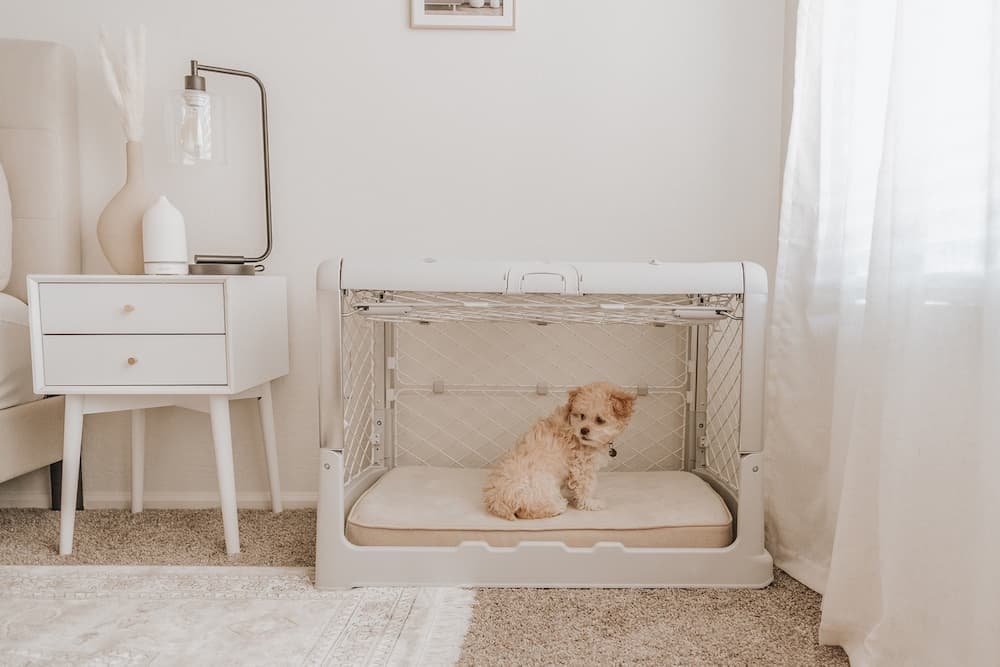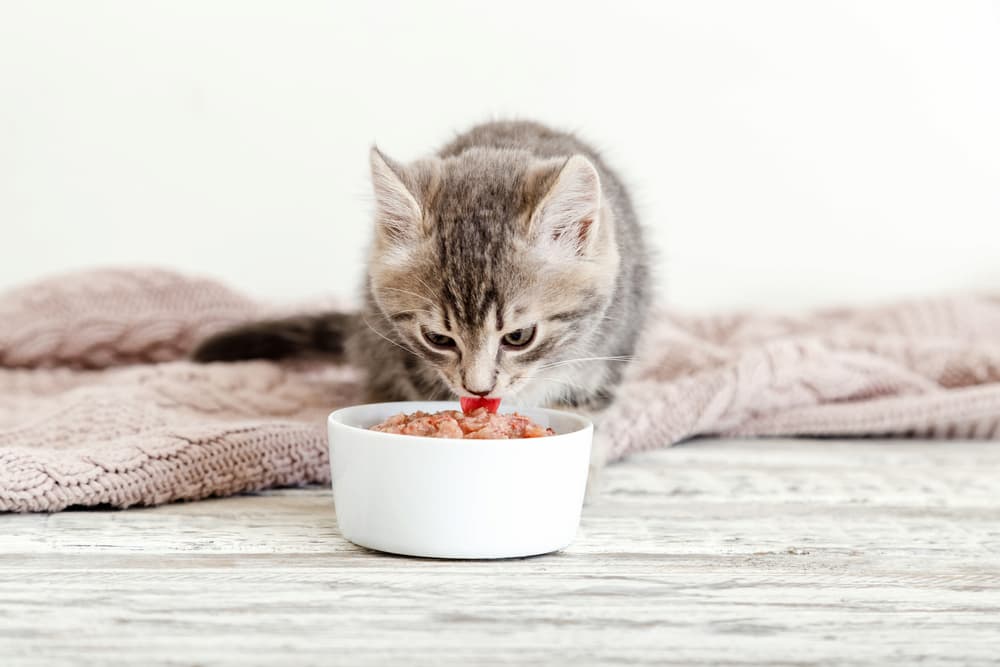
On October 31, millions of Americans will celebrate their favorite holiday with friends, family, and yes…their pets.
Even though the specter of the COVID-19 pandemic still lurks in the background, we can celebrate a spook-tacular holiday with our four-legged family members.
However, there are some preparations to take in order to avoid scared and stressed pets this season.
Halloween Things That Stress Pets Out

Despite their spooky origins, modern Halloween rituals are more fun than frightening. However, some Halloween festivities can cause anxiety and trigger fear in dogs and cats.
Let’s take a look at some Halloween traditions that may stress our pets out:
Spooky Decorations
Electronic props that make noise or pop up to scare trick-or-treaters can be downright terrifying to dogs and cats. Life-sized skeletons, witches, or even dog- or cat-shaped cutouts can trigger fearful or even aggressive behavior in some pets that think they are real people or animals.
Seeing decorations in new or unexpected places, such as your neighbor’s yard, can be an unwelcome surprise to your dog when you take him on a walk. The giant blow-up pumpkin perched on your neighbor’s roof might get a chuckle out of you, but send your dog into a barking fit.
Halloween Costumes
Halloween costumes allow us to become someone different—which is exactly why they may alarm your dog or cat. Your dog may not realize that the “Spiderman” before him is actually “Dad” or that the broomstick-wielding woman sporting a Gryffindor robe is actually “Mom.”
Your pup may not want to participate in your Halloween adventure dressed as a spider or a Snitch, especially if he isn’t used to wearing outfits that may be restricting or uncomfortable. He may even react fearfully or aggressively if you dress other pets up in outfits since they don’t look like themselves either.
Trick-or-Treaters and Visitors
Because of the pandemic, trick-or-treating door-to-door and Halloween parties may be limited in many areas of the country (much to the delight of dogs and cats). Many dogs and cats find the constant ringing of the doorbell and stream of oddly dressed trespassers extremely stressful.
While some dogs and cats may hide or even bark or hiss at the intruders, other pets may escape through the door and disappear into the night.
Tips for Helping Pets Deal With the Halloween Scaries

You wouldn’t look for a Halloween costume last minute. So planning a safe Halloween for your pets shouldn’t be a last minute decision either. With some preparation, you and your pet can have a safe and stress-free Halloween.
Take these precautions to help avoid Halloween-related anxiety:
Learn Signs of Stress
Observe your pet’s behavior and body language for signs of fear, anxiety, and stress. Generally speaking, pinned ears, a tucked tail, crouched posture, and hiding are signs of fear in both dogs and cats. In fact, the “Halloween cat” silhouette—a cat with an arched back and “bottle brush” tail denotes a cat that is extremely terrified and fear aggressive.
If your dog or cat is unwilling or unable to participate in activities he or she normally enjoys (e.g. eating a treat, playing fetch), it’s likely because he or she is stressed.
If you see any of these signs, evaluate the environment from your pet’s perspective to determine what may be causing him or her to be upset and try to eliminate it.
Start Early and Add Slowly
Start planning Halloween early and add decorations gradually. Just put out a few at a time, so your pet has plenty of time to get used to them.
Create Positive Associations
Halloween is all about treats! Reward your pet for tolerating their costume by offering them a tasty treat or engaging them in play while they wear it. Bravery should be rewarded too—praise and treat your pet for an absence of fearful behavior when he or she sniffs and then ignores the giant pumpkin on the floor or the cackling witch by the front door. Take treats on walks to reward your dog for his willingness to walk past the neighbor’s lawn decorated with hundreds of fake cobwebs blowing in the wind.
Practice Makes Perfect
If your neighborhood allows door-to-door trick-or-treating this year, accustom your dog to hearing the doorbell ring repeatedly. Several weeks before Halloween, enlist a friend or family member to ring the doorbell every 2-3 minutes for 15 minutes. Each time the doorbell rings, call your dog to you, instruct him to sit, and reward him with a treat.
If he likes visitors and won’t run out the door, tell your dog to stay while you open the front door and pretend to greet the visitor. Don’t forget to reward him for staying.
Consider Designating a Safe Space
If your dog (or your cat) doesn’t like visitors or might escape when the door is open, consider installing a baby gate to keep them away from the front door.
You may need to confine your dog or cat to another room. If your dog or cat is not used to being separated from you, spend the weeks leading up to Halloween getting them used to being confined. Put your dog or cat in another room for just a few minutes at a time. Give him or her something fun to do in the room such as a long-lasting tasty treat to chew on or a new toy to play with. Gradually increase the duration of confinement a few minutes each time.
Celebrate At a Distance
Have a safe and socially distant Halloween by keeping your pets inside and meeting trick-or-treaters outside the house. Another option is to leave a basket of individually packaged goodies (and hand sanitizer) outside so you don’t have to pass them out by hand. Consider celebrating online by posting pictures of you and your pet in costume or via a virtual get-together.
Consider an Anti-Anxiety Product for Your Pet
Scary should not equal stressful. If your pet is fearful or anxious leading up to Halloween, talk to your vet. He or she may recommend an anti-anxiety product to provide stress relief so you and your pet can enjoy this magical time of year.
Other Halloween Pet Safety Tips

Toxic temptations abound during Halloween. To prevent a trip to the emergency room with your pet, keep him or her away from these Halloween hazards.
Chocolate
Chocolate, particularly dark or baker’s chocolate, contains a chemical called theobromine which can cause agitation, stomach upset, racing heart, high pressure, tremors and an elevated temperature.
Xylitol
Xylitol is an artificial sweetener used in some candies, gum, and other foods. It can cause a life-threatening drop in blood sugar resulting in collapse and seizures and liver failure.
Raisins and Grapes
These tasty additions can be found in candy or Halloween recipes. But be aware before feeding these to your pets because they can cause kidney failure in some animals.
Small Toys
Small children’s toys are fun party gifts but can be swallowed by pets resulting in stomach or intestinal obstruction.
Alcohol
Dogs that drink beer, wine or other drinks containing alcohol may appear “drunk” (difficulty walking, vomiting) but in more severe cases, alcohol poisoning can result in coma, seizures, and death.
Fire Hazards
Never leave candles, especially those in Jack-O-Lanterns, unattended and keep them out of reach from pets that may inadvertently knock them over or get burned by them. Unplug electric decorations and devices when not in use and keep them out of reach from pets that might chew on them.
Open Doors and Windows
Pets may become scared and try to escape through open doors or windows. Always know where your pets are before opening doors to greet guests or trick-or-treaters. Just in case Fluffy or Fido escape, make sure your pet’s ID tags and/or microchips are up-to-date with your current contact information.
Halloween 2020 festivities will be different than years past but we can still have a purr-fectly petrifying Howl-O-ween with our four-legged ghouls and goblins by taking a few precautions and proactive steps.






